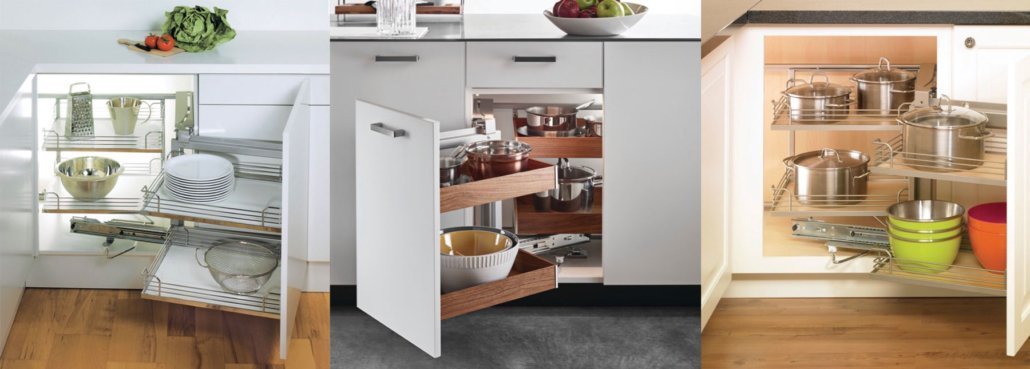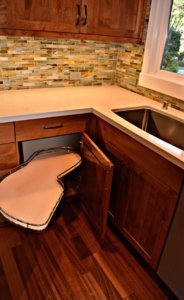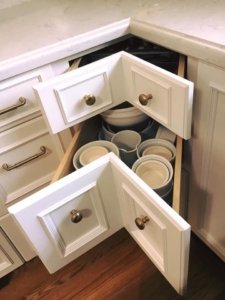Clever Storage for Corners in Kitchens

When redesigning a kitchen layout, Harrell designers frequently need to be creative to maximize storage in corners. Older kitchens often left these corners very difficult to access, but there are now more creative solutions. There are generally two types of corner storage, Lazy Susans and another option referred to as a “Blind Corner”.
According to Harrell Certified Kitchen Design, Gloria Carlson, corner cabinets occur in the majority of kitchens. “I generally specify about four variations of corners during kitchen remodels,” Gloria states. “Depending upon the size available, I recommend either a Lazy Susan, or a Blind Corner with a ‘Magic Corner’ or ‘LeMans’ system.”
Interested in a remodel? Harrell Design + Build can help!
Most people are familiar with a Lazy Susan, a circular “plate” that spins, enabling easy access to everything housed on its flat surface. Lazy Susans are the most efficient use of space in a corner cabinet. They require 36” in both directions at the corner and function in much the same manner as the table-top device or ones frequently used to hold spices.
There are three main styles of Lazy Susans, the first being a unit with two flat, spinning surfaces that are attached to a center pole, but these can be flimsy, so Gloria rarely chooses them. A “Super Susan,” has spinning flat surfaces that sit on stationary shelves, making them more sturdy and also avoiding items from falling off into inaccessible areas. The third type of Lazy Susan is a push-through Lazy Susan, in which the soft-close cabinet doors fold in on themselves and the interior storage units spin outside the cabinet for extra easy access.

The other storage option that Gloria recommends is for blind corners, which requires 27” in one direction and 48” in the other. Two popular Blind Corner options are the Magic Corner and the LeMans system. These storage systems tend to be utilized when the blind corner space is shorter on one side than the other. Comprised of multiple baskets or shelves, the LeMans and Magic Corner are designed so that one unit slides forward and out when the door is opened while the rear storage units move into the cabinet opening, providing complete access.
“I work closely with all of my clients to understand how they function in their kitchens. This, in addition to the available space in the corner, will give me the information needed to make product recommendations,” Gloria explains.
Whichever corner storage option is chosen, ideal access must be considered. A bifold door hinged in the middle is often specified for a Lazy Susan, whereas Blind Corner cabinets typically have a single hinged door on the long side of the cabinet. With a bifold door on a Lazy Susan, Gloria carefully considers the hinge side that works best with how homeowners work in the space, allowing them maximal access to the contents of the cabinet. A push-through door can make sense when access with a bifold door is more limited.
“If corners are situated near a range or cooktop, the door should open away from the appliance,” explains Gloria.

Though much less common, it is possible to have drawers in corners, though they require the creation of uniquely shaped corner drawers and also don’t effectively utilize the available space.
Special corner storage features are most frequently found in base cabinets but occasionally occur in wall cabinet configurations as well. Upper cabinet corners are limited to the use of Lazy Susans.
If you are contemplating a kitchen remodel, it is very likely that your cabinet layout will result in corner cabinets. By understanding your storage options as well as by working with a designer who knows their stuff, those once awkward areas can be transformed using some unique storage solutions.
Considering updating your kitchen? We invite you to schedule a complimentary consultation with a member of Harrell’s design team to help you explore your kitchen, bath, or home remodeling project.










